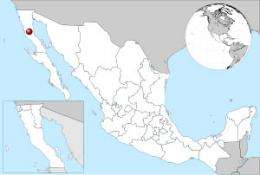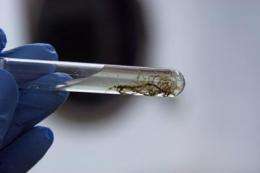Two strains of bacteria team up, thrive on limited resources

In a discovery that further demonstrates just how unexpected and unusual nature can be, scientists have found two strains of bacteria whose symbiotic relationship is unlike anything seen before.
Long, thin, hairlike Thioploca (meaning "sulfur braids" in Spanish) trichomes form chains down into marine sediment, which tiny Anammox cells ride down like an elevator. At the bottom, the Anammox cells consume nitrite and ammonium, or "fixed" nitrogen, the waste products of the Thioploca.
Why is this research important to astrobiology?
One goal of NASA's Astrobiology Program is to understand the limits and constraints on life in extreme environments, and the strategies some organisms use to survive such extremes—providing a critical foundation for the search for life beyond Earth.
The research was conducted off the coast of Baja California, in the anoxic sediments of the Soledad basin at the Mexican Pacific margin. There, bacteria species like Thioploca and Anammox must solve critical challenges.
Implications for climate change
Nitrogen is a crucial building block of life, a prerequisite for photosynthesis. While nitrogen is present in abundance in the Earth's atmosphere, to be useful for most living organisms, the nonreactive atmospheric di-nitrogen gas that diffuses into the ocean from the air must be converted into the biologically available "fixed" forms ammonium, nitrate and nitrite by specialized organisms called nitrogen fixers. Other organisms use up this fixed nitrogen and convert it back to di-nitrogen gas.

Living together in the mud beneath areas of high plant productivity, Thioploca and Anammox intensify this part of the nitrogen cycle.
"There is a growing body of evidence that oceans will be become less oxygenated due to global warming," says Prokopenko. [The thioploca-anammox partnership] occurs in the absence of O2, therefore, it is likely to become more important in the future. But at the same time, it provides a way to put "breaks" on algal growth by enabling anoxic sediments to remove biologically available nitrogen more efficiently than previously thought. Algal growth ultimately drives anoxia (consumes O2). By reducing the amount of fixed nitrogen, the thioploca/anammox consortium ultimately helps the ocean to stay more oxygenated."
The symbiosis, however, isn't one creating widespread change throughout the ocean, but rather one that creates localized zones where fixed nitrogen is depleted faster than most expected.
Astrobiology Magazine contacted Dr. Maria Prokopenko, lead author of the study that appeared in Nature earlier this month, and co-author Dr. William Berelson, for further insights.
The diffusion problem
"Life often concentrate in areas of steep chemical gradients (where chemistry changes significantly), which are often present in the sediments," explains Prokopenko. "These gradients are likely to be present in sediments or stratified oceans on other planets. However, the main "nemesis" for organisms living along these chemical gradients is the slow diffusion of necessary nutrients."
Thioploca lives at the interface between water and sediments. It feeds on two main chemicals: sulfide and nitrate. One (nitrate) is present in abundance in the water above, and diffuses downwards into the sediments. The other (sulfide) is produced below within the sediments, and diffuses upwards. Often, there is a vertical gap between nitrate and sulfide, which Thioploca has to bridge.
It does so by building the sheaths to move up and down through the mud. The sheaths are like soft Chinese noodles, approximately 0.2-0.5 mm in diameter, made of polysaccaride, or sugar molecules linked together. They can go as deep as 20 cm below the sediment-water interface. Thioploca can move through them much faster than it'd take for the nutrients to diffuse through the sediments.
Anammox cells have figured out how to tap into this biological aqueduct, riding Thioploca like an elevator, living off its waste (thereby removing components that are likely toxic for Thioploca). So both microbes thrive where others perish.
The newly discovered partnership is a strategy we could potentially see if we were to find life on another planet.
"The symbiosis occurs between two "chemolithotrophs"—organisms that use inorganic substrate as their source of metabolic energy—and it is purely chemical," says Prokopenko. It seems to be a good strategy to survive in chemically "challenging" environments, where essential compounds for life are scarce."
"When we find a bacterial syntrophy (when one bacteria species lives off the products of another species)," adds Berelson, co-author on the study, "and actually demonstrate how it works, it further confirms what many of us believe—that if there is energy to be obtained, bacteria will find a way to live off this energy."
Journal information: Nature
Source: Astrobio.net


















